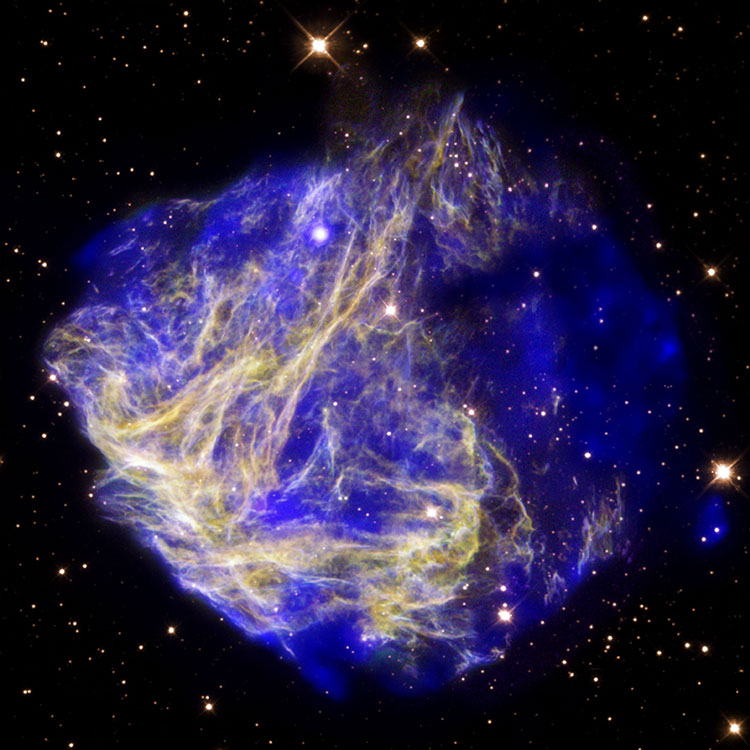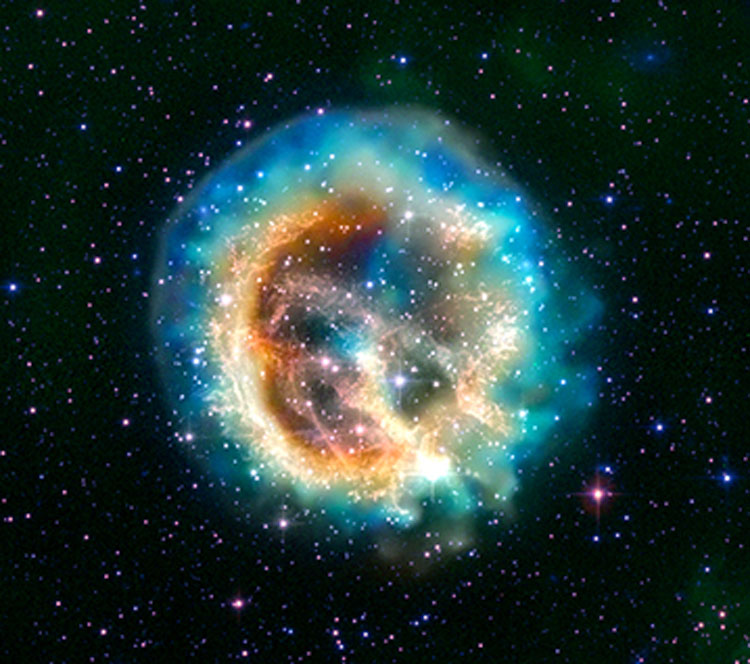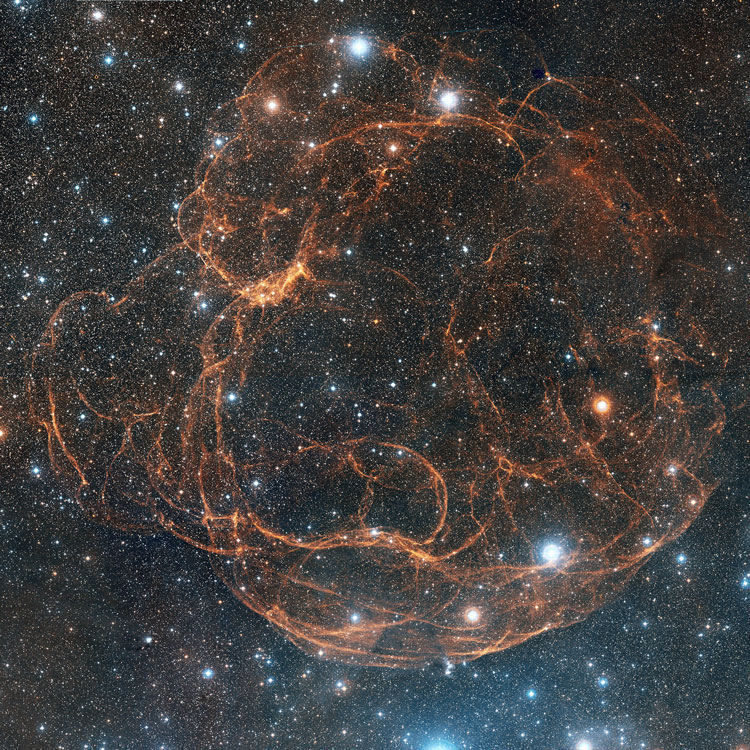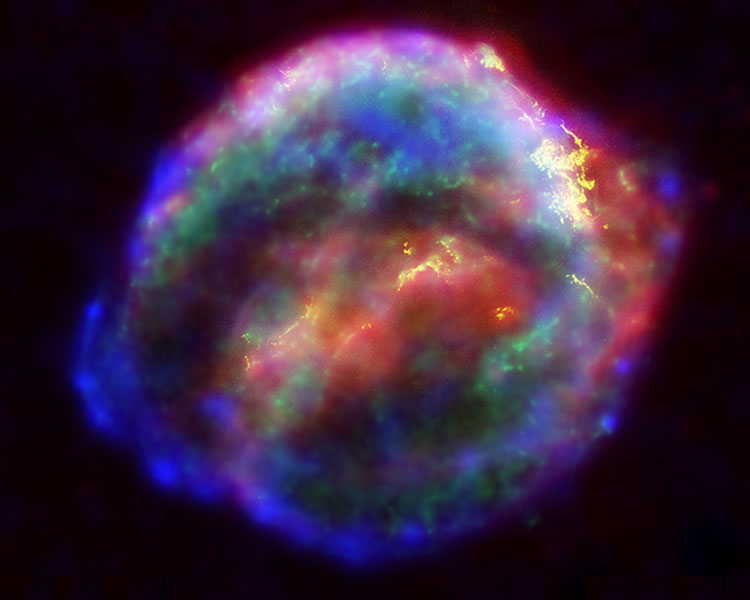|
The eventual purpose of this page will be to discuss supernovae and their remnants, meaning the nebulae left behind by their explosion, and to lead into a discussion (on other pages) of the "dead" stars resulting from supernova explosions -- white dwarfs, neutron stars, and black holes. For now, it serves only as a convenient placeholder for images which may be used to illustrate the page once completed.
Supernova remnant N49, in a composite of visual and X-ray images

(Credits X-ray: NASA/CXC/Penn State/S. Park et al.; Optical: NASA/STScI/UIUC/Y. H. Chu & R. Williams et al)
The Vela Supernova remnant
 About 12000 years ago a massive star died and violently scattered its outer layers across interstellar space. The filamentary structure in this image is the remnant of that supernova. About 800 light years away and 100 light years across, the remnant spans 8 degrees in the southern sky. Note: The non-filamentary structures also seen in this image are emission nebulae not associated with the supernova remnant. (Image Credit Digitized Sky Survey, ESA/ESO/NASA FITS Liberator
Color Composite Davide De Martin (Skyfactory))
E0102-72, a supernova remnant in the Small Magellanic Cloud

About 190,000 light years away, the supernova which created this remnant must have occurred about 190,000 years ago; but based on the appearance and physical characteristics of the remnant, we see it as it was about a thousand years after the explosion, so the currently visible structure represents a thousand years of expansion. (Image Credit NASA, CXC, MIT, D. Dewey et al., SAO, J. DePasquale, STScI)
Simeis 147, a supernova remnant just east of El Nath (the tip of one horn of Taurus, the Bull)

About 3,000 light years away, the supernova which created the remnant shown in this DSS image lit up the night skies of Earth about 100,000 years ago. About 3 to 5 degrees across (for the main and outer portions of the expanding cloud), it is 150 to 200 light years in diameter. Its intricate filamentary structure is caused by shock wave heating of interstellar gas slammed into by the rapidly expanding gases ejected by the supernova. (Image Credit Davide De Martin & the ESA/ESO/NASA Photoshop FITS Liberator, spacetelescope.org)
Supernova remnant SN1006, in Lupus

In 1006, what was probably the brightest supernova in recorded history lit up Earth's skies. The image above (a composite of visible, X-ray and radio radiation) shows the thousand year old cloud of debris racing away from the site of the explosion. The cloud is now about 60 light years across, suggesting an average expansion rate of 3% of the speed of light (about 6 thousand miles per second). Its symmetrical shape suggests that it was caused by a type Ia supernova -- the utter destruction of a white dwarf companion of a massive star, which reached critical mass as the other star shed its outer layers and dumped them onto the white dwarf (see Mass Transfer in Binary Star Systems).
(Image Credit X-ray: NASA/CXC/Rutgers/G.Cassam-Chenai, J.Hughes et al.; Radio: NRAO/AUI/NSF/GBT/VLA/Dyer, Maddalena & Cornwell; Optical: Middlebury College/F.Winkler, NOAO/AURA/NSF/CTIO Schmidt & DSS)
Above, a closeup of a thin ribbon of expanding gas in the same structure
(Image Credit NASA, ESA, Hubble Heritage (STScI/AURA); Acknowledgement: W. Blair et al. (JHU))
The remnant of Tycho's Supernova of 1572

This cloud of expanding gas is the remnant of Tycho's Supernova, the "nova" in Casseiopeia which stirred his interest in astronomy, and allowed him to prove that the heavens were not immutable (that is, unchanging). See Tycho Brahe's Astronomical Accomplishments for a discussion of the supernova's effect on his life, Mass Transfer in Binary Star Systems for a discussion of type Ia supernovae, in which a white dwarf companion to a massive star is utterly destroyed, and the image credit link immediately following for more information. (Image Credit X-ray: NASA/CXC/SAO; Infrared: NASA/JPL-Caltech; Optical: MPIA, Calar Alto, O. Krause et al.)
The remnant of Kepler's Supernova of 1604

Above, a cloud of expanding gas that is the remnant of Kepler's Supernova, the most recent supernova observed within our own galaxy. The remnant is 12 to 20 thousand light years away, in the direction of Ophiuchus. Its appearance and chemical composition indicate that as in the case of Tycho's Supernova, it was produced by the destruction of a white dwarf. (Image Credit NASA/CXC/NCSU/S. Reynolds et al.) Below, a composite of visible, infrared and X-ray images from HST, Spitzer and Chandra space telescopes (Image Credit NASA/ESA/JHU/R.Sankrit & W.Blair)
Supernova remnant SNR0104

(X-ray: NASA / CXC / Penn State / S.Park & J.Lee; Infrared: NASA / JPL-Caltech)
|